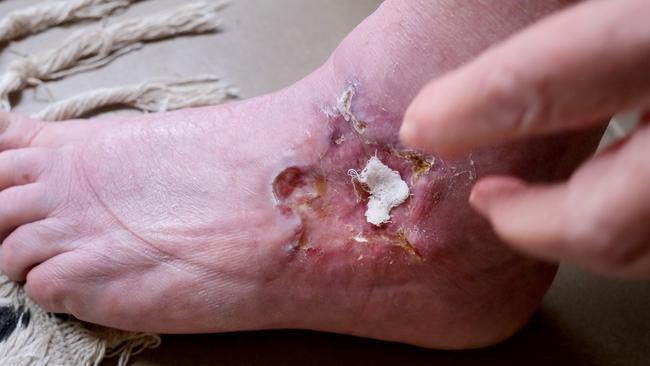Greater Geelong records worst year on record for flesh-eating ulcer as Leopold woman reveals toll
Geelong has racked up its worst year on record for an ugly infection, which a Leopold woman says left her unable to drive for nine months. WARNING: GRAPHIC
Geelong
Don't miss out on the headlines from Geelong. Followed categories will be added to My News.
Geelong has racked up its worst year on record for cases of a flesh-eating ulcer which a local woman described as the most painful and debilitating experience of her life.
The infection, known as the Buruli or Bairnsdale ulcer and caused by mycobacterium ulcerans, can eat away skin and fat cells, and cause gangrene and tissue loss.

Greater Geelong has recorded 36 cases of mycobacterium ulcerans so far this year, health department figures reveal.
The previous highest annual total for the municipality was 35 cases recorded in 2012, according to the data going back to the 1990s.
The ulcer left Leopold 74-year-old Bev O’Meara unable to wear a shoe on her left foot or drive for nine months.
She described her battle with the infection as “the most painful and debilitating thing” that had ever happened to her.
Mrs O’Meara noticed swelling and a red spot on her lower left limb in October last year.
She initially thought it was a spider bite, and was prescribed two courses of antibiotics.
In December last year, Mrs O’Meara was hospitalised due to how much pain she was in.
Tests confirmed she had the Buruli ulcer.
“I couldn’t bear it,” she said.
“I had pain, fever and chills.
“It had to be dressed all the time, when it was exposed the pain was unbearable.”
She had a debridement surgery, where the ulcer was cleaned.
Between December last year and July she had four stays in hospital due to the ulcer, totalling about five weeks.
Mrs O’Meara has undergone two further debridements, a skin graft procedure, and had a vacuum-assisted closure dressing fitted to her foot.
After months in pain, Mrs O’Meara said the ulcer finally began to heal in August this year, and she could put a shoe on that foot at last.

However, she still requires ongoing treatment and her foot has not fully healed.
Research has shown a correlation between humans contracting the ulcer and the presence of mosquitoes and possums carrying the mycobacterium ulcerans bacteria.
Mrs O’Meara urged people to be cautious of mosquito bites and go to a doctor if they suspected they had the ulcer.
Barwon Health infectious disease specialist Associate Professor Daniel O’Brien confirmed there had “certainly” been an increase in Buruli ulcer cases in the Greater Geelong region.
“People being at home more often due to lockdowns could be a factor in the case numbers, but more research is required to determine the reasons, including whether or not we can expect the trend to continue,” Prof O’Brien said.
Prof O’Brien said the Barwon South West public health unit, established in January, would have a role to play in responding to Buruli ulcer, including managing cases, tracking the disease, and researching the causes.
The Borough of Queenscliffe has recorded six cases of mycobacterium ulcerans so far this year, and the Surf Coast four.
More Coverage
Originally published as Greater Geelong records worst year on record for flesh-eating ulcer as Leopold woman reveals toll





